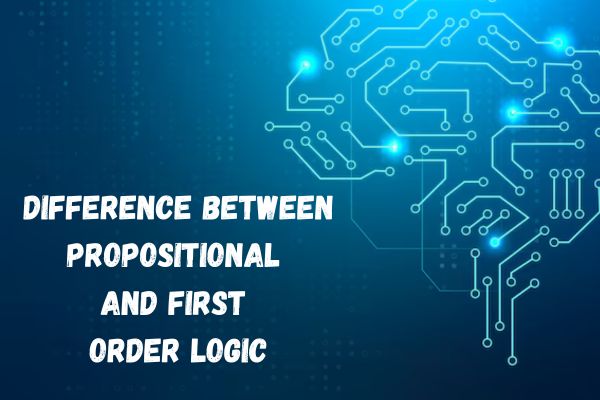Among the many logical systems used in AI, Propositional Logic (PL) and First-Order Logic (FOL) are two of the most foundational. Both play essential roles in AI reasoning, but they differ in expressiveness, complexity, and real-world applications. This article dives into their differences, making it accessible, engaging, and valuable to both AI enthusiasts and beginners.
Also See: Emotional AI for Therapy and Counseling: Transforming Mental Health Care
Difference Between Propositional and First Order Logic
Understanding Propositional Logic (PL)
Propositional Logic, also known as Boolean Logic, deals with simple statements that are either true or false. It uses propositions (atomic statements) connected by logical operators such as AND (∧), OR (∨), and NOT (¬). Each proposition is treated as a whole unit without internal structure.
Example of Propositional Logic
Consider the statements:
- P: It is raining.
- Q: The road is wet.
Using logical connectives, we can form rules like:
- P → Q (If it is raining, then the road is wet)
- ¬P (It is not raining)
- P ∧ Q (It is raining and the road is wet)
Strengths of Propositional Logic
- Simplicity: Easy to understand and implement.
- Well-Defined Operations: Uses clear and straightforward rules.
- Useful in AI Applications: Common in basic decision-making systems and simple rule-based AI.
Limitations of Propositional Logic
- Limited Expressiveness: Cannot capture relationships or properties of objects.
- Scalability Issues: Becomes impractical for large, complex problems requiring object-specific reasoning.
Also See: What Challenges Does Generative AI Face with Respect to Data?
Understanding First-Order Logic (FOL)
First-Order Logic (FOL), also called Predicate Logic, extends Propositional Logic by introducing quantifiers, variables, and relations. This allows it to represent more complex statements about objects and their interactions.
Example of First-Order Logic
Let’s expand on our previous example with objects and relations:
- Rain(x): x is rain.
- Wet(y): y is wet.
- Causes(x, y): x causes y.
Now, we can express:
- ∀x (Rain(x) → ∃y Wet(y)) (For all x, if x is rain, then there exists y such that y is wet)
- Causes(Rain, Wet(Road)) (Rain causes the road to be wet)
Strengths of First-Order Logic
- More Expressive: Can represent objects, properties, and relationships.
- Handles Complex AI Applications: Used in knowledge representation, natural language processing (NLP), and expert systems.
- Better Generalization: Allows reasoning about categories of objects instead of just specific facts.
Also See: What Purpose do Fairness Measures serve in AI Product Development
Limitations of First-Order Logic
- More Complex: Requires more computational power than Propositional Logic.
- Higher Learning Curve: Harder to implement and understand for beginners.
- Computationally Expensive: The more expressive the logic, the more time-consuming it is to process.
Key Differences Between Propositional Logic and First-Order Logic
| Feature | Propositional Logic (PL) | First-Order Logic (FOL) |
|---|---|---|
| Representation | Simple propositions | Uses objects, relations, and quantifiers |
| Expressiveness | Limited | More powerful and flexible |
| Scalability | Becomes impractical for large problems | Handles complex domains |
| Computation | Less computationally expensive | More computationally expensive |
| Example Usage | Basic AI rules, circuit design | NLP, expert systems, semantic reasoning |
Why Does This Matter in AI?
Understanding the distinction between PL and FOL is crucial for AI development. Propositional Logic is great for simple rule-based systems, whereas First-Order Logic is necessary for AI applications that involve reasoning over objects, such as NLP, automated theorem proving, and semantic search.
For example, NLP relies heavily on FOL because human language is structured with entities, relationships, and context. When a chatbot understands a user’s question, it must recognize not just words but also their relationships, which is where First-Order Logic excels.
Real-World Applications
Propositional Logic in AI
- Digital Circuit Design: Logic gates in computers use PL.
- Expert Systems: Some rule-based AI models use PL for decision-making.
- Search Algorithms: AI planning systems use PL for basic state transitions.
First-Order Logic in AI
- Natural Language Processing (NLP): Understanding the meaning of sentences beyond just words.
- Semantic Web Technologies: Helps AI interpret and process structured data.
- Autonomous Systems: Self-driving cars use FOL to reason about objects and their relationships.
Conclusion
Both Propositional Logic and First-Order Logic serve essential roles in AI, but they cater to different levels of complexity. If you’re working with simple true/false statements, PL is your go-to logic. However, if you need to model relationships, properties, and reasoning over entities, FOL is indispensable.
As AI continues to evolve, the ability to represent and manipulate knowledge efficiently will determine how intelligent systems interact with the world. Whether you’re an AI researcher, developer, or enthusiast, understanding the difference between PL and FOL is a key step toward mastering AI logic systems.
